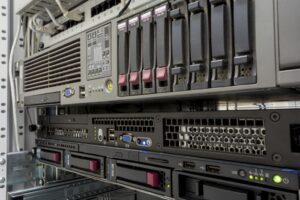San Diego RAID Server Recovery


With RAID storage, we can access and store huge amounts of data quickly and easily. Unfortunately, our reliance on the system means that RAID server loss or damage can be destructive and debilitating to your home network or business. Keep reading to see how you might be affected, and to learn what could be recovered in case of data loss.
How Do RAID Servers Work?
The “I” in the acronyminitially stood for inexpensive, but RAID is now known as the redundant array of independent disks. At a computing conference 1988, Randy Katz, David Patterson, and Garth Gibson presented a paper to describe RAID, a new method of using multiple disk drives for data storage. These disk drives extend storage space and capability while still acting as a single device, boosting both capacity and performance.
RAID storage has five levels, or schemes, which offer better protection against data loss than solitary disk drives. Data may be divided, duplicated, and distributed differently depending on the required availability and reliability. In this way, RAID offers advanced protection against data loss due to its offered redundancy. By storing identical data in multiple places, you are better protected against data loss. This duplicating and sorting process also helps makes RAID server recovery possible and easy.
Remote volume managers or dedicated computer software or hardware are most commonly used to control your RAID array type and server. Many current operating systems support RAID use.
Causes of Server Damage
The levels and schemes of RAID are designed to help protect against data loss, but damaged or malfunctioning systems can cause huge problems. Protect your system from extreme temperatures and natural disasters as much as possible, but know that mechanical damage is one of the principal causes of a broken RAID array or server failure. At this point, simple rescue software may not be enough for a complete RAID server recovery.
Can My Data Be Retrieved?
For small cases involving simple data loss or misplacement, you can utilize do-it-yourself software that can help guide you through the recovery process. This method of recovery is ideal for small batches of corrupted or accidentally deleted files, for which you can simply search the server. Once you locate the files you need, you can restore the original data or replicate and send it to a new location.
If the server damage seems too extensive or you note mechanical failure, recovery software likely will not be enough. No matter the cause of loss or underlying issues, however, complete RAID server recovery is possible. Due to the scheme’s complex nature, however, retrieving data from a failed device requires a deeper level of technical understanding and experience.
You best option is to consider seeking assistance from a specialty data recovery service such as InterData Recovery Services. Look for a specialized company with experience in handling RAID server recovery operations. In addition, seek a service that works on-site and refuses to outsource or otherwise share your disks and data. With a high-qualified team of experts working for you, you have the best-possible chance at recovering everything you need while minimizing your downtime.